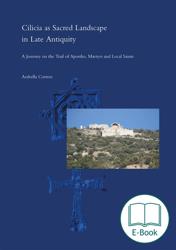Kilikien, am südlichen Rand Kleinasiens gelegen, war ein besonderer Ort, dessen strategische Lage den Austausch künstlerischer und religiöser Ideen begünstigte. Die Gegend wurde lange Zeit vor allem mit dem berühmten Pilgerort des Theklaheiligtums bei Seleukeia am Kalykadnos oder mit der Figur des Hl. Paulus von Tarsos in Verbindung gebracht. Ihre historische Landschaft war jedoch in der frühbyzantinischen Zeit durch zahlreiche weitere Heilige geprägt, deren Verehrung Spuren in literarischen, epigraphischen und archäologischen Quellen hinterließ.
In der vorliegenden Arbeit werden unter Berücksichtigung der landschaftlichen Merkmale der Region eine detaillierte archäologische Analyse mit der Interpretation hagiographischer Quellen (von denen viele bisher unerforscht und unübersetzt waren) kombiniert, um die Gestaltung und den Einfluss der kilikischen Pilgerorte zu rekonstruieren. Die Reise eines fiktiven Pilgers in der Spätantike bildet den Rahmen für die Darstellung der archäologischen Untersuchungen und führt den Leser vom rauen Bergland in die Ebenen Kilikiens, um so zu entdecken, wie Heiligkeit erfahren wurde, die von einem besonderen Umgang mit der Natur geprägt ist.
Cilicia as Sacred Landscape in Late Antiquity is a journey of discovery of the rich religious landscape of Cilicia in Asia Minor in Late Antiquity, with its contrasting and fascinating natural landscapes. Famous and prosperous cities of Cilicia Pedias such as Tarsos and Anazarbos welcomed pilgrims from distant western lands on their way to Jerusalem, attracted by famous stories about their saints and especially the Apostle Paul. The rugged mountains that characterized the western part of Cilicia (so-called Isauria) concealed places of worship associated mainly with the memory of Saint Thekla, whose place of pilgrimage was located a few kilometres south of the city of Seleukeia on the Kalykadnos, and of local martyrs, like Saint Konon, who were sometimes venerated internationally.
The present book examines all the archaeological and architectural evidence (building remains, inscriptions, decorations, mosaics, coins) that testify to the veneration of saints in Cilicia and Isauria, and integrates them with hagiographic evidence that tells us, above all, about the places where the saints stayed, performed their miracles, and died. Particular attention is paid both to the physical characteristics of the region, which strongly influenced the construction of religious structures in certain places and shaped their form (often integrated into the landscape), and to the historicity of the sites. Indeed, numerous churches were built on earlier pagan structures (temples, thermae, agora, rock or water sanctuaries). The central questions of the book are concerned with how martyria and pilgrimage sites affected the spatial planning (roads, accessibility, buildings) of the region, how the worship of a saint was organized in its pilgrimage sites, how existing structures contributed to the sacrality of a site and offered a continuity with the past, and, finally, how the particular relationship between sacrality and nature was enacted architecturally.
This volume is an archaeological work that focuses on the late antique process of creating sacred space in a marginal but extensively travelled region of Asia Minor. Combining the architectural and archaeological analysis of Christian church buildings and martyria with literary sources attesting the cult of a saint, it aims to reconstruct the sacred landscape of an underestimated region through the lens of a pilgrim and contributes towards the understanding of the pilgrim networks on the way to Jerusalem.
Arabella Cortese, born in 1983 in Pisa, studied archaeology at the University of Pisa and earned her doctorate in Late Antique and Byzantine Art History at Ludwig Maximilians University, Munich (2016–20). Between 2017 and 2020, she worked as a research assistant at the University of Regensburg (DFG-GRK 2337 – Metropolität in der Vormoderne) and, since July 2021, has been working on her postdoctoral project “Holy Water in Late Antiquity: Sensory Experiences at the lieux de mémoire of Christian Healing Traditions” at the Zentralinstitut für Kunstgeschichte in Munich.
In 2020, she published the proceedings of a conference organized in Munich in May 2018 on her research topic “Cilicia in Late Antiquity” as Identity and Cultural Exchange in Ancient Cilicia: New Results and Future Perspectives, International Colloquium 18-19 May 2018 in Munich, Mitteilungen zur Spätantiken Archäologie und Byzantinischen Kunstgeschichte 7, (Reichert Verlag, Wiesbaden 2020). In 2022, Cortese published two other books: the conference volume Urban Space Between the Roman Age and Late Antiquity: Continuity, Discontinuity, and Changes (Schnell & Steiner Verlag, Regensburg 2022) together with Giulia Fioratto, and a book on the architectural history of the medieval church of S. Andrea in Foriporta in Pisa (A. Cortese, La chiesa di Sant'Andrea in Foriporta a Pisa. Dal rilievo alle fasi costruttive, Pacini Editore, 2022 e-book).
In addition to late antique and Byzantine sacred architecture, other research interests include early Christian cults of saints and martyrs, the staging of sanctity in Late Antiquity, and late antique urban space, sites of memory, and sacred landscape in Asia Minor and the Near East.
Diese Schriftenreihe widmet sich speziell den Forschungen zur Christlichen Archäologie und Kunstgeschichte in spätantiker und frühchristlicher Zeit. Sie umfasst die gesamte Epoche der Spätantike bis zum frühen Mittelalter, im Bereich des byzantinischen Reiches auch darüber hinaus.
Die Reihe ist überkonfessionell und ohne Bindung an bestehende Institutionen, arbeitet jedoch mit der „Arbeitsgemeinschaft Christliche Archäologie zur Erforschung spätantiker, frühmittelalterlicher und byzantinischer Kultur“ zusammen. Sie konzentriert sich vor allem auf die Kunstdenkmäler und versteht sich daher nicht als Konkurrenz, sondern als Ergänzung zu schon bestehenden Reihen, die in der Regel nicht nur die materielle Hinterlassenschaft der alten Kirche, sondern stets auch literarische, theologische und philologische Themen behandeln.
Einer klareren Zuordnung und einer größeren Bandbreite der verschiedenen Disziplinen wegen wurden zwei Unterreihen eingerichtet:
Die Reihe A „Grundlagen und Monumente“ setzt sich schwerpunktmäßig mit einzelnen Denkmälern bzw. Denkmalgruppen im Sinne einer korpusartigen Erfassung der Denkmäler auseinander.
In der Reihe B „Studien und Perspektiven“ werden einerseits Vorträge der Tagungen der „Arbeitsgemeinschaft Christliche Archäologie“ publiziert, andererseits bietet sie ein Forum für Untersuchungen zu den verschiedensten Fragen aus dem Gebiet der spätantiken/byzantinischen Archäologie und Kunstgeschichte.


 Table of Contents
Table of Contents